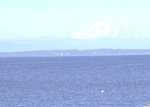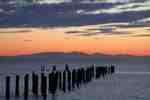We live in Point Roberts, WA. You probably never heard of it and there’s no reason you should have. It’s an “exclave,” a locale that is physically separate from the larger geo-political entity it is part of. There are several of these in the US. The Lake of the Woods in Minnesota has the large swath of land and lake known as the Northwest Angle and the tiny Elm Point. Another is the town of Alburgh, Vermont and the other is us, Point Roberts, in the far northwest corner of Washington State.
Point Roberts stands out from the others in this odd-ball category. The Northwest Angle has a full-time population of only 119 hardy souls spread out over some 600 square miles which is mostly water. Elm Point is an uninhabited marsh and Alburgh’s claim to exclavativity is compromised by a bridge linking it by road to the US. There are a couple of other chunks of land along the border with Canada that may qualify but they are tiny and uninhabited so no one cares.
It’s an accident of geology and politics. When the border between the US and what was to become Canada was set at the 49th parallel in the 1840s, the focus was on Vancouver Island (which all agreed should be part of the Commonwealth) and the islands that dot what we now call the Salish Sea. The final decision on how to distribute possession of the islands was made, interestingly, by the Kaiser who was brought in to mediate between opposing claims.
Things ended up surprisingly fair with the border jumping around so that roughly half the territory went to the Commonwealth (and ultimately Canada when she declared independence) and half to the US. But with all this attention to the islands, no one took much notice of this little peninsula, less than five square miles in area, hanging down below the 49th. The Commonwealth offered to take it. The US said “no thank you, a deal’s a deal.” It wanted it for military reasons and for fishing. The former was never developed; the latter became, for a time, an important industry.
And so here it was and here it still is. Right now some 1,300 folks live here full-time. In the summer months the population swells to over 5,000 as visitors pour in from Canada and elsewhere. It is a very odd place, quirky with a rich, intriguing history and its modest population has (far) more than its share of eccentrics.
Canadians actually own roughly 70% of the property – most are cottages and small houses that are only used during the summer and holidays. Interestingly however, Canadians are responsible for, according to the latest estimates, nearly three-quarters of the tax revenue generated here.
Many of the Americans who have lived here all their lives are dual citizens because they were born in hospitals in Canada, mostly Vancouver General. Until some twelve years ago there were no medical services and the onset of labor was typically followed by a trip to VGH.
There are five (yes, five!) gas stations and five shipping and mailing businesses. Actually there are six, counting the US post office which has fully one thousand post boxes almost of which are rented by folks north of the border. The US Consulate in Vancouver uses us for official mailing to US destinations. The reasons? Gasoline across the border was $5.75/gal this morning; shipping a package to a US destination from Canada can run four times the cost of shipping it from The Point and a letter sent from Vancouver to a US address will set you back $1.16, not 46¢.
Our tiny border is, remarkably, the fifth busiest crossing with Canada behind only Niagara Falls, Detroit, Port Huron and Blaine, WA with some 2.5 million trips back and forth a year.
Those are the basics, dry and banal. The actual living of life here is far more interesting, far more. I’ll blog some more about this in the days to come but for fun go to Google Earth and zoom in. Come down close and look at what is just above the border, in Tsawwassen, BC. They have dense housing (and that wide open swath to the east is soon to be more of it); we have rural, low density housing and forest. They have strip malls, sidewalks and street lights and traffic, noise and crime. We have none of that. Now pull back. Vancouver is a 40 minute drive away, the airport 25 (closer than JFK is to Manhattanites or O’Hare is to Chicagoans), the ferry to Vancouver Island and the smaller Gulf Islands a mere 20. Those mountains above Vancouver have three skiing resorts – where parts of the Winter Olympics were held in ‘12.
When you gaze eastward across Boundary Bay, Mt. Baker looms over you.
From the west side you can watch the sun set.
Indeed, The Last Nowhere Surrounded by Somewhere. More later.
